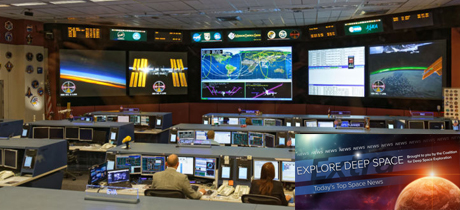In Today’s Deep Space Extra… NASA’s Johnson Space Center weathers major storm Harvey, turning to small numbers of essential personnel only to staff Mission Control in support of the International Space Station and support thermal vacuum testing of the James Webb Space Telescope.
Human Space Exploration
How NASA’s Johnson Space Center is riding out the hurricane
Ars Technica (8/29): An essential only team of professionals at NASA’s Johnson Space Center has managed to keep the installation’s Mission Control Center operating in support of the six person International Space Station this week in response to hurricane turned tropical storm Harvey. They’ve also kept the James Webb Space Telescope secure within an Apollo era, very low temperature, and thermal vacuum chamber at Johnson in preparation for a late 2018 launch.
Marshall Space Flight Center unveils largest SLS hardware
WAFF-TV of Huntsville, Alabama (8/28): NASA’s Marshall Space Flight Center displayed its largest piece of hardware assembled for the Space Launch System exploration rocket. The Launch Stage Vehicle Adapter separates core and second stages of the rocket designed to start human explorers on future missions of deep space exploration.
Space Science
Scientists track asteroid flyby of Earth set for October 12
Space.com (8/29): Asteroid 2012 TC4 is to pass close to the Earth on October 12. NASA is coordinating efforts to use the approach to simulate a global response to a possible future impact. The closest approach of 2012 TC4, however, is estimated at 27,000 miles. The space rock is estimated at 30 to 100 feet across, similar to the small asteroid that detonated in the atmosphere over Chelyabinsk, Russia in February 2013.
Time travel isn’t possible or is it?
Space.com (8/29): Ohio State University astrophysicist Paul Sutter explains how we might slow time and control aging by accelerating rapidly into space. “You could stop for a few hours, have a picnic near Sagittarius A* (the black hole at the center of the galaxy), and then hop back in to your rocket and come back to Earth. By the time you return you’ll be eligible for retirement benefits, if the institution providing those benefits is even around, because while you only traveled for a few decades according to the clock on your ship, about 40,000 years would’ve passed on the Earth,” writes Sutter.
Watch Asteroid 3122 Florence zip past Earth this weekend
Universe Today (8/29): Asteroid 3122 Florence is to pass 4.4 million miles from Earth on Friday just after 8 a.m., EDT. At 2.7 miles in diameter, this space rock is fairly large, large enough at the distance to catch a glimpse. Universe Today explains where to glance.
Other News
Boeing donates $1 million to assist Hurricane Harvey recovery and relief efforts
Coalition Member in the News
CW39-TV of Houston (8/29): The Boeing Co., of Chicago, is donating $1 million through its charitable trust to the American Red Cross to help Houstonians recover from storm damages linked to hurricane Harvey.
What’s tops the agenda for a New Space Colony? A debate over taxes
Wall Street Journal (8/29): In Russia, talk of a space future turns to Asgardia, an orbital settlement, and how to fund it.
Pentagon list could clear the way for licensing of advanced commercial imaging systems
Space News (8/29): The Pentagon has developed exclusionary zones that would permit commercial satellite imaging using two infrared shortwave and nighttime imaging technologies. The action could ease a long running logjam for licensing of the advanced systems.
NASA data relay craft successfully blossoms in space
Spaceflightnow.com (8/29): Launched from Cape Canaveral Air Force Station, Florida, on August 18, NASA’s TDRS-M communications relay satellite has reached geosynchronous orbit and deployed giant antennas and solar arrays. TDRS-M is part of the communications link that supports the International Space Station and other spacecraft like the Hubble Space Telescope and Earth observing missions.

